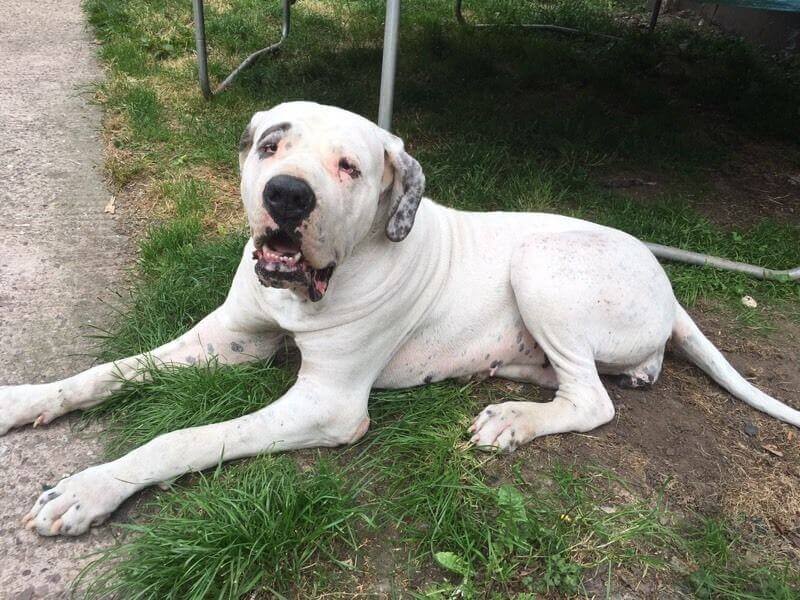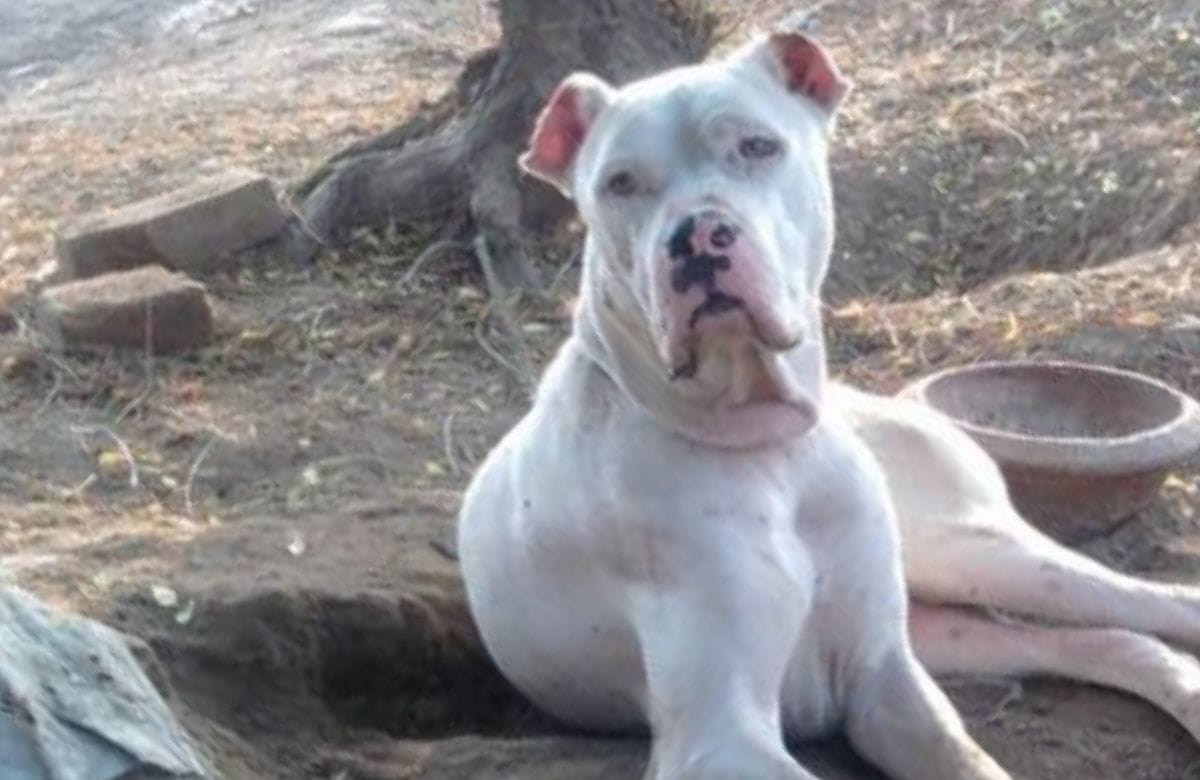Bully Kutta, also known as the Indian Mastiff, is a breed of dog that originated in Pakistan. The breed is known for its muscular build and powerful jaws, which make it a formidable opponent in dog fighting. Despite its reputation as a fighting dog, the Bully Kutta is also a loyal and protective companion to its owners.

The breed's name translates to "heavily wrinkled dog" in Urdu, which refers to its wrinkled skin and muscular build. The Bully Kutta is a large breed, standing at around 36 inches tall and weighing up to 170 pounds. Its coat is short and smooth, and can come in a variety of colors including white, black, brown, and brindle.
While the Bully Kutta is popular in Pakistan and other parts of South Asia, it is relatively unknown in other parts of the world. However, its impressive size and strength have caught the attention of dog enthusiasts in recent years, leading to an increase in demand for the breed. Despite this, it is important to note that the Bully Kutta requires experienced handling and training due to its powerful nature.
History and Origin
Cultural Significance
Bully Kutta, also known as the "Beast from the East," is a powerful and muscular dog breed that originated in the Indian subcontinent. This breed was highly valued in the regions of Rajasthan and Sindh, where it was used for various purposes such as guarding, hunting, and fighting.

The Bully Kutta has a rich cultural significance in the Indian subcontinent, where it is considered a symbol of strength and power. It is often associated with the warrior class and was used by the Rajput kings for hunting and guarding their palaces.
Development and Breeding
The exact origin of the Bully Kutta is uncertain, but it is believed to have descended from the Alaunt, a breed of dog that was used by the nomadic tribes of Central Asia. The Indian Alangu Mastiff is also thought to have contributed to the development of the Bully Kutta.
Over time, the breed was selectively bred for its strength, agility, and fighting ability. This led to the development of a powerful and muscular dog that was well-suited for combat. Today, the Bully Kutta is still used for fighting in some parts of the world, although it is also kept as a companion and guard dog.
In the 16th century, the Bully Kutta was introduced to the Indian subcontinent by the Mughal Empire, which ruled over much of the region at the time. The breed quickly gained popularity among the local rulers and was used for various purposes, including hunting and guarding.
In conclusion, the Bully Kutta is a breed with a rich history and cultural significance in the Indian subcontinent. Its development and breeding over time have resulted in a powerful and muscular dog that is well-suited for various purposes. Despite its association with fighting, the Bully Kutta can also make a loyal and devoted companion.
Physical Characteristics
Size and Weight
The Bully Kutta is a large and powerful breed of dog that typically stands between 30 and 44 inches tall at the shoulder. They can weigh anywhere from 120 to 230 pounds, with males being larger and heavier than females.
Coat and Colors
The Bully Kutta has a short, smooth coat that is easy to maintain. They come in a variety of colors, including white, black, red, brindle, and fawn. Some dogs may also have a harlequin pattern, which is a mix of black and white.
Distinctive Features
One of the most distinctive features of the Bully Kutta is their heavily wrinkled face and loose skin. They also have a thick-boned, muscular build that gives them a powerful appearance.
In terms of coat, the Bully Kutta's short coat is ideal for their native climate in Pakistan, where they were originally bred. The coat is easy to maintain and does not require a lot of grooming.
Overall, the Bully Kutta is a striking and impressive breed of dog that is known for their size, strength, and distinctive appearance.
Temperament and Behavior
Personality Traits
Bully Kuttas are known for their confident and strong-willed personality. They are intelligent dogs that require a firm and consistent hand in training. They are also very loyal and protective of their family, making them excellent guard dogs.
Guarding and Protective Nature
Bully Kuttas are naturally protective of their family and property. They have a strong guarding instinct that makes them excellent guard dogs. They are highly alert and will bark at any perceived threat. However, early socialization is important to prevent aggression towards strangers.
Interaction with Family and Other Animals
Bully Kuttas are affectionate towards their family and love to be around them. They are good with children but should always be supervised due to their large size. They can be dominant towards other dogs and should be socialized early to prevent aggression towards other animals.
Overall, Bully Kuttas are energetic and protective dogs that require a confident and knowledgeable owner. With proper training and socialization, they can make excellent family pets and guard dogs.
Health and Care

Common Health Issues
Bully Kuttas are generally healthy dogs, but they are prone to some health issues. One of the most common health issues is hip dysplasia, which is a genetic condition that affects the hip joint. Arthritis is another common issue that affects Bully Kuttas, especially as they age. Allergies can also be a problem for some dogs, causing skin irritation, itching, and other symptoms. Blindness can occur in some dogs, particularly as they get older.
Diet and Nutrition
Bully Kuttas need a balanced diet that is high in protein and rich in nutrients. They should be fed a diet that is appropriate for their age, size, and activity level. Vegetables can be included in their diet, but they should not be the main component of their meals. It is important to avoid overfeeding Bully Kuttas, as they can easily become overweight.
Exercise Requirements
Bully Kuttas are active dogs that require regular exercise. They need daily walks and playtime to keep them healthy and happy. Regular exercise can help prevent obesity, which is a common problem in Bully Kuttas. It is important to provide them with enough exercise to keep them mentally and physically stimulated.
Grooming Needs
Bully Kuttas have a short, smooth coat that requires minimal grooming. They shed moderately, so regular brushing can help keep their coat healthy and shiny. They are not heavy droolers, but they may drool occasionally. It is important to keep their teeth clean by brushing them regularly to prevent dental problems. Bully Kuttas have a lifespan of 8-10 years on average, but with proper care, they can live longer.
Training and Socialization
Basic Obedience
Bully Kuttas are highly intelligent dogs that require proper training to ensure they grow up to be well-behaved and obedient. Basic obedience training is crucial for all dogs, and the same goes for Bully Kuttas. It is recommended to start training them as early as possible to ensure they learn the basic commands such as sit, stay, come, and heel. Positive reinforcement techniques, such as treats and praise, work well with Bully Kuttas as they respond well to rewards.
Social Skills
Socialization is an essential aspect of training for any dog, including Bully Kuttas. Proper socialization helps them develop good behavior and manners around people and other animals. Socializing a Bully Kutta should start at a young age and involve exposing them to different situations, people, and animals. This process helps them become more confident, independent, and well-adjusted dogs.
Managing Aggression
Bully Kuttas are natural guard dogs and can display aggression towards strangers. Therefore, it is important to manage their aggression through proper training and socialization. It is recommended to keep them on a leash when in public places and to supervise their interactions with other dogs and people. Owners should be patient and consistent in their training to ensure their Bully Kutta learns to control their aggression.
In summary, proper training and socialization are crucial for Bully Kuttas to grow up to be well-behaved and obedient dogs. Basic obedience training, social skills, and managing aggression are all important aspects of training that should be addressed. With patience, consistency, and positive reinforcement, owners can ensure their Bully Kutta becomes a confident and well-adjusted dog.
Bully Kutta in Society
The Bully Kutta, also known as the Indian Mastiff, is a large dog breed that has been historically bred for guarding and hunting purposes. In modern times, this breed has been gaining popularity as a working dog and a loyal companion. However, the breed has also been associated with controversy due to its use in dog fighting and its potential danger to humans.
Role in Security and Hunting
Bully Kuttas were originally bred in Pakistan and India for guarding and hunting purposes. They were used to protect livestock and property from predators and intruders. In modern times, the breed is still used as a guard dog in some parts of the world. Due to their large size and loud bark, they can be an effective deterrent to potential intruders.
Legality and Controversy
The Bully Kutta has been associated with controversy due to its use in dog fighting. Dog fighting is illegal in most countries, and owning a fighting dog can lead to legal consequences. Additionally, the breed's potential danger to humans has led to some countries banning or restricting ownership of the breed.

Popularity and Ownership
Despite the controversy surrounding the breed, the Bully Kutta has gained popularity in recent years. They are known for their loyalty and protective nature, and can make excellent companions for experienced dog owners. However, due to their large size and potential danger, they require proper training and socialization.
Overall, the Bully Kutta is a powerful and loyal dog breed that has played an important role in society for centuries. While their use in dog fighting and potential danger to humans has led to controversy, they can make excellent companions for experienced dog owners who are willing to provide proper care and training.
Breed Variations and Related Breeds
Regional Variants
The Bully Kutta, also known as the Indian Mastiff, is a breed that has several regional variations. One of the most famous regional variations is the Alangu Mastiff, which is a larger and more muscular version of the Bully Kutta. The Alangu Mastiff was bred for hunting and fighting purposes and is known for its strength and courage.
Another regional variation of the Bully Kutta is the Pakistani Mastiff, which is similar in appearance to the Indian Mastiff but is slightly smaller and has a shorter coat. The Pakistani Mastiff is also used for hunting and fighting purposes and is known for its loyalty and protective nature.
The Sindhi Mastiff is another regional variation of the Bully Kutta, which is found in the Sindh province of Pakistan. The Sindhi Mastiff is smaller in size compared to the Indian Mastiff and has a shorter coat. It is used for guarding and protecting livestock and is known for its intelligence and agility.
Similar Mastiff Breeds
The Bully Kutta belongs to the Mastiff family, which includes several other breeds such as the English Mastiff, the Bullmastiff, and the Tibetan Mastiff. The English Mastiff is one of the largest breeds of dogs and is known for its gentle and affectionate nature. The Bullmastiff, on the other hand, is a cross between the English Mastiff and the Bulldog and is known for its strength and agility.
The Tibetan Mastiff is a large and powerful breed that is known for its protective nature and loyalty. It is often used as a guard dog and is known for its thick and luxurious coat. The Bulldog is a smaller breed compared to the Mastiffs but is known for its courage and tenacity. It was originally bred for bull-baiting but is now a popular companion dog.
The Bully Kutta is often compared to the American Pitbull, which is a smaller and more agile breed. However, the Pitbull is not a Mastiff breed but is a type of dog that was originally bred for fighting purposes. The Bully Kutta, on the other hand, was bred for hunting and guarding purposes and is known for its strength and courage.
Ownership Considerations
Cost of Ownership
Owning a Bully Kutta can be a significant financial commitment. The cost of purchasing a puppy from a reputable breeder can range from $1500 to $5000. In addition to the initial purchase price, there are ongoing expenses to consider such as food, grooming, veterinary care, and training. It is important to budget accordingly and be prepared for the financial responsibility of owning a Bully Kutta.
Finding a Reputable Breeder
When looking for a Bully Kutta puppy, it is important to find a reputable breeder who prioritizes the health and temperament of their dogs. A good breeder will be knowledgeable about the breed, perform health testing on their breeding dogs, and provide proper socialization for their puppies. It is recommended to visit the breeder in person and ask to see the living conditions of the dogs. A reputable breeder may also have a waiting list for their puppies, so it is important to plan ahead.
Adoption and Rescue
Adopting a Bully Kutta from a rescue organization can be a more affordable option than purchasing a puppy from a breeder. Rescue organizations may have Bully Kuttas of various ages and temperaments available for adoption. It is important to research the rescue organization and ask questions about the dog's history and behavior. Adopting a rescue dog can be a rewarding experience, but it is important to be prepared for any potential behavioral or health issues that may arise.
Overall, owning a Bully Kutta requires careful consideration and preparation. It is important to research the breed and understand the financial and time commitments involved. With proper care and training, a Bully Kutta can make a loyal and loving companion.

Conclusion
In conclusion, the Bully Kutta is more than just a powerful and imposing breed; it's a symbol of loyalty and resilience with a rich cultural history. Appreciating the unique characteristics of this breed fosters responsible ownership and dispels any misconceptions surrounding it.
Frequently Asked Questions
- Q1: Are Bully Kuttas good family pets?
- Yes, with proper training and socialization, Bully Kuttas can make excellent family pets, especially for those looking for a loyal and protective companion.
- Q2: What is the average lifespan of a Bully Kutta?
- The average lifespan of a Bully Kutta is around 8 to 12 years, with proper care and attention to their health.
- Q3: Do Bully Kuttas require a lot of exercise?
- Yes, Bully Kuttas are an active breed that requires regular exercise to maintain their physical and mental well-being.
- Q4: Can Bully Kuttas adapt to apartment living?
- While possible with proper exercise, Bully Kuttas thrive in environments with enough space for their energetic nature.
- Q5: How do I choose the right Bully Kutta variety for me?
- Researching the different strains and considering their temperaments can help you choose a Bully Kutta variety that suits your lifestyle and preferences.




